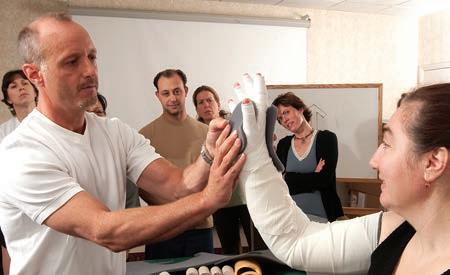An update on the genetics of primary lymphedema
 By Kristiana Gordon
By Kristiana Gordon
Introduction: The term “primary lymphedema” is used to describe swelling of any body site that has occurred as a result of a developmental fault in the structure or function of the lymphatic pathways and is presumed to be genetic in origin. There are many different subtypes of primary lymphedema, and it should not be considered as one single condition.
Thelymphatic system has been largely ignored by medical and scientific communities until recently, leading to a lack of progress in the management of lymphedema compared to other diseases. This perceived lack of interest was probably due to difficulties in visualizing the lymphatic system (since the vessels are transparent), understanding its function, and a lack of effective drug treatments. However, physicians and researchers are now more engaged as a result of recent advances in lymphatic research. The development of diagnostic genetic tests and pharmaceutical drug trials has provided additional encouragement that more can be offered. It is highly likely that continued research will lead to better investigations and treatments for all patients with lymphedema in the near future.
The lymphatic system
The lymphatic system is now recognized as an important part of the circulatory and immune systems. It has several functions including:
1) maintenance of fluid balance by returning lymph from the interstitial spaces to the blood circulation, and
2) maintaining immune function (i.e. detecting an infection in the body and then generating an immune response to fight it). When the lymphatic system fails it causes the accumulation of protein-rich lymphatic fluid within interstitial spaces. This swelling is known as lymphedema, usually affecting one or more limbs, with associated brawny changes of the skin. Lymphedema also
causes an increased risk of local infection (e.g. cellulitis/erysipelas) due to impaired immune surveillance within the swollen area.
Secondary lymphedema
Lymphedema may develop in people with a previously healthy/normal lymphatic system that becomes damaged (for example, by trauma or cancer treatment) and this is called ‘secondary lymphedema’. This is the most recognized type of lymphedema.
Primary lymphedema
‘Primary lymphedema’ occurs when a person is born with a genetically determined fault of their lymphatic system (Image 1). It is unclear how common primary lymphedema is due to a lack of prevalence studies. However, it is likely to affect at least one person in every 6,000, based upon a study done in the 1980s (Dale, 1985). This is supported by the number of patients cared for in the Primary Lymphoedema Clinic at St. George’s Hospital in London (more than 1000 families seen in the clinic to date, with > 100 new referrals every year).
Primary lymphedema occurs as a result of a genetic predisposition causing the lymphatic system to fail to develop normally, or to be maintained adequately. This causes abnormal drainage of lymphatic fluid, which results in swelling of the affected region (Connell, Brice et al 2010). Primary lymphoedema may occur as an inherited condition from a parent, but
Dr. Kristiana Gordon is an Associate Professor and Consultant Physician in Dermatology & Lymphovascular Medicine. She is Clinical Lead of the Lymphoedema Service at St. George’s Hospital, London where her team cares for thousands of patients with primary and secondary lymphedema, and has a doctorate in the genetics of primary lymphedema and imaging of the lymphatic system.
often there is no family history. A patient with primary lymphedema usually only has problems with swelling of one or two limbs, but some rarer forms of primary lymphedema may occur in association with health problems e.g. congenital heart problems in lymphedemadistichiasis syndrome, systemic (internal) lymphatic abnormalities (e.g. fluid around the heart or lungs) in the rare Hennekam syndrome, or leukemia in the very rare Emberger syndrome (Connell, Gordon et al 2013).
Primary lymphedema is not one single disease, but the presenting feature of several distinct clinical disorders/diseases. Each type of primary lymphedema is likely to have a different “mechanism of disease”, i.e. a specific part of the lymphatic system fails to function normally. For example, some types of primary lymphedema occur because of faulty valves within the lymphatic vessels, and another type because of fluid absorption issues. It is important to understand the mechanism of lymphatic transport failure in our patients, where possible, as we hope one day to be able to offer more effective targeted treatments. In other words, we may be able to offer tailor-made treatment plans depending on the subtype of primary

lymphedema and the underlying gene mutation. Even though someone with primary lymphedema will have an underlying gene mistake/ mutation since birth, the swelling often develops later in life. Historically, primary lymphedema was categorized into three groups purely depending on the patient’s age at onset of swelling: ‘lymphedema congenital’ (presenting at birth), ‘lymphedema praecox’ (pubertal onset) or ‘lymphedema tarda’ (swelling onset after 35 years of age). Some physicians still use this rudimentary classification system, but it fails to take into account any health problems that might be associated with the lymphedema, thereby failing to provide prognostic information.
A Primary Lymphedema Classification Pathway
In the last two decades, mutations in several genes have been discovered to cause primary lymphedema. Some, but not all, of these genes have been shown to play a role in lymphangiogenesis (the body’s process of developing and maintaining a healthy lymphatic system). Fifteen causal genes have now been discovered,

but these mutations are only detected in one quarter of our patients. In other words, we have only discovered the underlying genetic cause of a patient’s primary lymphedema in 25% of cases. The other 75% will have an as-yet-undiscovered gene mutation as the cause. New gene mutations are continually being identified by lymphatic researchers, so we expect the diagnostic detection rate to continue to increase.
The discovery of these gene mistakes has changed our diagnostic approach in the clinic, which is now based on clinical phenotyping (i.e. the process of associating a patient’s lymphedema with any other health problems) and genotyping (DNA blood tests looking for the underlying causal gene mistake). The clinical experience and research from the St. George’s Primary Lymphoedema Clinic led us to realize that primary lymphedema can be broadly divided into five different categories. Causal gene mistakes/mutations have been identified for a number of disease subtypes within these five categories. We subsequently developed a colour-coded diagnostic pathway that describes specific primary lymphedema conditions and
guides the patient’s physician on genetic tests that may be available for their patient, annotated in red within the pathway boxes (Image 2).
Five subtypes of primary lymphedema

1 Genetic syndromes associated with lymphedema (blue section of the pathway): In this group of patients the swelling is not the predominant feature of the child’s health problems, but simply part of their overall condition. Examples include Turner syndrome where some girls are born with swollen feet and/or hands. Some children with Noonan syndrome also develop lymphedema of their legs in childhood.

The development of diagnostic genetic tests and pharmaceutical drug trials has provided additional encouragement that more can be offered.
2 Lymphedema with systemic (internal) lymphatic abnormalities (pink section):
This rare form of primary lymphedema does not affect many children. These children may be swollen at birth (usually affecting many limbs/body parts) and have internal lymphatic problems. These internal problems may include fluid around the heart and/or lungs. They may also have abnormal lymphatic drainage of the small intestine, which means they cannot absorb fats properly, causing them to have diarrhea when they eat fatty foods. One example of this rare problem is Hennekam syndrome due to a mistake in one of several genes (e.g. CCBE1, FAT4 or ADAMTS3).
3 Lymphedema in association with overgrowth of tissues (yellow section):

Lymphedema may develop in patients that have overgrowth of tissues within the swollen limb
e.g. the muscle, bone and/or fatty tissues are increased in size. There are several conditions within this group, including Klippel-Trenaunay syndrome where a child may have lymphedema, varicose veins, red/purple birthmarks of
the skin and a longer (or sometimes shorter) limb. We are realizing that some of these conditions develop because of a PIK3CA gene mistake within the swollen limb tissue (this is called a ‘mosaic’ problem), and the gene mistake will not be found in their blood DNA. Small skin biopsies are taken from the red birthmark areas to identify the causal gene mistake. Drug treatments that target the PIK3CA/mTOR pathway can sometimes be offered to patients with a confirmed genetic mutation who are suffering with progressive overgrowth problems. This type of treatment is only offered by physicians with a special interest in these conditions, and not by family physicians or lymphedema therapists.
4 Congenital lymphedema (green section):
Congenital lymphedema describes lymphedema/swelling that is present at birth or develops within the first year of life. There are several different causes but the most recognized is Milroy disease. This condition causes swelling of the feet and ankles at birth, sometimes varicose veins develop after puberty,
and one third of boys may develop a buildup of lymphatic fluid within the scrotum (hydroceles). Milroy disease is due to a mutation in the VEGFR3 gene. Children of affected individuals have a 50% risk of inheriting the problem. In this condition, the initial small lymphatic vessels fail to absorb (“suck up”) the lymphatic fluid properly from the tissues in the lower legs. However, the prognosis for people with Milroy disease is often very good as the swelling does not progress above the knees, and there are no serious associated health problems.
5 Late-onset primary lymphedema (purple section):
The term “late-onset lymphedema” is used to describe a primary lymphedema that develops after the first year of life (i.e. non-congenital lymphedema). Lymphedema distichiasis syndrome is one example. It presents with bilateral lower limb lymphedema that typically develops after puberty. Distichiasis (extra eyelashes) is present from early childhood and may cause eye irritation. Other problems may include varicose veins, cleft palate and heart issues
(rare problems with the valves of the heart). Lymphedema distichiasis syndrome occurs as a result of mutations in the FOXC2 gene, and children of affected individuals have a 50% risk of inheriting the problem. The FOXC2 mutation causes abnormal valve development within the lymphatic vessels, i.e. the mechanism for the development of lymphedema is that the abnormal valves can’t keep lymphatic fluid draining in one direction towards the heart. Another example of late-onset primary lymphedema is Meige disease (the commonest form of primary lymphedema and a subtype that is not associated with any other health problems).
Treatment
Unfortunately there is no gene therapy for primary lymphedema yet, nor proven curative treatments for lymphedema in general. Several surgical techniques have been implemented in recent years in a bid to improve lymphatic drainage in patients with secondary lymphedema. However, these are unlikely to significantly benefit patients with primary lymphedema, as they do not have an “obstruction” within their lymphatic system,
rather a molecular/genetic abnormality that cannot simply be bypassed with an operation.
Management should be aimed at improving and controlling swelling through physical treatments designed to stimulate lymphatic flow through existing or collateral drainage routes. This management approach is essentially the same as for patients with secondary lymphedema. Treatment is overseen by lymphedema therapists and will usually involve the use of compression (garments and/or bandaging regimes), with or without manual lymphatic drainage massage. Regular exercise, skin care (including management of cellulitis), healthy eating, and self-care (especially when children mature and become independent) are vital components of lymphedema management too.



Conclusion
Healthcare professionals’ knowledge of primary lymphedema has significantly increased in recent years. The St. George’s diagnostic pathway helps physicians to offer appropriate genetic testing (assuming the underlying gene mistake is known for the subtype), and to screen and




treat for associated health problems for patients with primary lymphedema. Patients and families benefit from receiving a formal diagnosis of their condition as it allows the physician to confidently predict the clinical prognosis. The pathway also helps the physician to offer genetic tests, and to interpret the results. This is relevant in this new age of whole genome sequencing where several mutations may be identified and the physician must decide if the results are meaningful for their patient (correlation with the classification pathway can be enormously helpful in this situation). In addition, use of this pathway has facilitated the discovery of new causative genes, as we analyze and compare the DNA of patients with similar patterns of lymphedema and other health problems. We are confident this ongoing research will result in the development of improved treatment options. The St. George’s diagnostic pathway is in the process of being revised once more and an updated version will be available in 2020 for physicians to utilize in their clinics. LP
A full set of references can be found at www.lymphedemapathways.ca
